

What is collaboration? What is it not? Collaboration. Catalan castellers collaborate, working together with a shared goal Collaboration is the process of two or more people or organizations working together to complete a task or achieve a goal.[1] Collaboration is similar to cooperation.
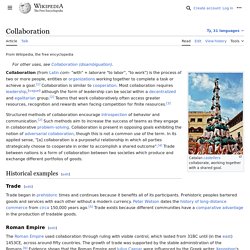
Most collaboration requires leadership, although the form of leadership can be social within a decentralized and egalitarian group.[2] Teams that work collaboratively often access greater resources, recognition and rewards when facing competition for finite resources.[3] Structured methods of collaboration encourage introspection of behavior and communication.[2] Such methods aim to increase the success of teams as they engage in collaborative problem-solving.
Three Types of Collaboration that Drive Innovation. A company that strives to be innovative must be collaborative.
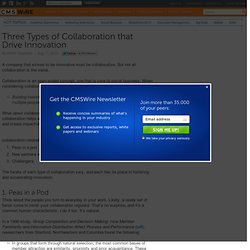
But not all collaboration is the same. Collaboration is an open-ended concept, one that is core to social business. When considering collaboration as a definition, here’s what I use: Building toward a defined outcome through the interactions and input of multiple people What about collaboration in the service of innovation? Let’s start by describing three types of collaboration related to innovation: Peas in a podNew partners in crimeChallengers The facets of each type of collaboration vary, and each has its place in fostering and accelerating innovation. 1. Think about the people you turn to everyday in your work. In a 1996 study, Group Composition and Decision Making: How Member Familiarity and Information Distribution Affect Process and Performance (pdf), researchers from Stanford, Northwestern and Columbia found the following: Group familiarity has a salutary effect on the interaction dynamics. 2.
Three types of collaboration: Anecdote. Nancy White and I have been working on a project to help our client enhance their collaboration practices.

In the process we’ve identified three types of enterprise collaboration. Love to hear what you think of the idea. Nancy is riffing on this topic too and has added a bunch of other cool resources in her post. Defining Collaboration: Four Types of Work. I've said that collaboration is about "people working with other people towards a common outcome.
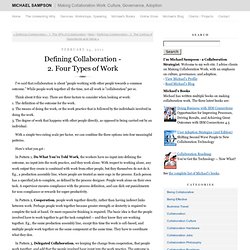
" While people work together all the time, not all work is "collaboration" per se. Think about it this way. There are three factors to consider when looking at work: 1. The definition of the outcome for the work. 2. The means of doing the work, or the work practice that is followed by the individuals involved in doing the work. 3. With a simple two-rating scale per factor, we can combine the three options into four meaningful patterns. Here's what you get - In Pattern 1, Do What You're Told Work, the workers have no input into defining the outcome, no input into the work practice, and they work alone. In Pattern 2, Cooperation, people work together directly, rather than having indirect links between work. In Pattern 3, Delegated Collaboration, we keeping the change from cooperation, that people work together, and add that the people involved have input into the work practice.
Which Kind of Collaboration Is Right for You? The Idea in Brief As potential innovation partners and ways to collaborate with them proliferate, it’s tough deciding how best to leverage outsiders’ power.
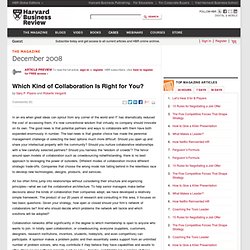
To select the right type of collaboration options for your business, Pisano and Verganti recommend understanding the four basic collaboration modes. These modes differ along two dimensions: openness (can anyone participate, or just select players?) And hierarchy (who makes key decisions—one “kingpin” participant or all players?). In the open, hierarchical mode, anyone can offer ideas but your company defines the problem and chooses the solution. Each mode has trade-offs. LEARNER INPUT. Coopetition. Why is this important?
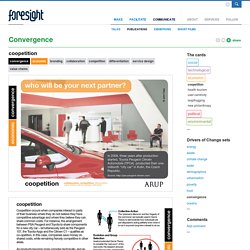
The creation of value chains which straddle several industries and products is likely to continue to increase. Who will we work with in the future to generate a new or larger market? Videos Berit Oskey’s Affinity Lab during the past nine years since she co-founded the company has helped more than 100 small businesses, entrepreneurs, and non-profits flourish by providing them with shared office space, a networked community, and the tools necessary to thrive in the DC region. Stephen Fry on QI introduces game theory via a truel, big brother and cigarette advertising. Noted on Pinboard… Coopetition occurs when companies interact in parts of their business where they do not believe they have competitive advantage and where they believe they can share common costs. As products become more complex technically, and branding increasingly becomes a way of differentiating value, companies have to forge sometimes uneasy alliances across traditional boundaries.
Close ↑